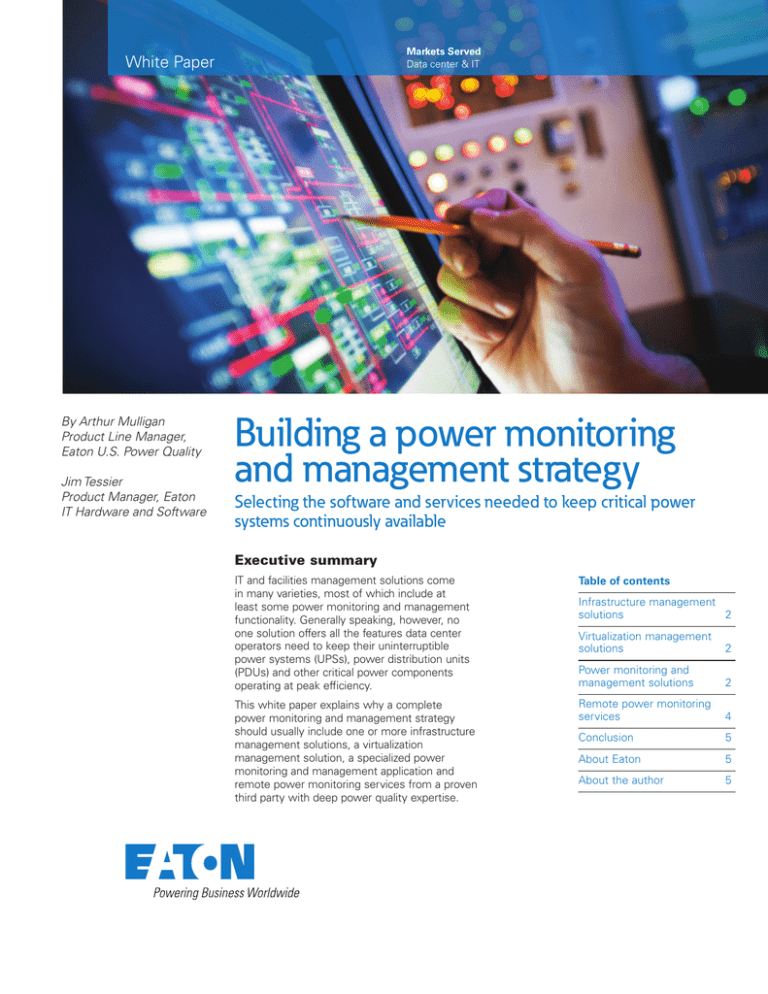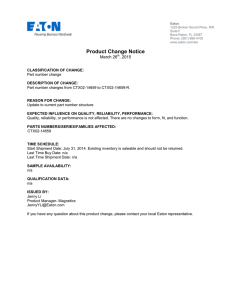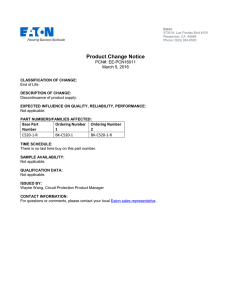
Markets Served
Data center & IT
White Paper
By Arthur Mulligan
Product Line Manager,
Eaton U.S. Power Quality
Jim Tessier
Product Manager, Eaton
IT Hardware and Software
Building a power monitoring
and management strategy
Selecting the software and services needed to keep critical power
systems continuously available
Executive summary
IT and facilities management solutions come
in many varieties, most of which include at
least some power monitoring and management
functionality. Generally speaking, however, no
one solution offers all the features data center
operators need to keep their uninterruptible
power systems (UPSs), power distribution units
(PDUs) and other critical power components
operating at peak efficiency.
Table of contents
This white paper explains why a complete
power monitoring and management strategy
should usually include one or more infrastructure
management solutions, a virtualization
management solution, a specialized power
monitoring and management application and
remote power monitoring services from a proven
third party with deep power quality expertise.
Infrastructure management
solutions
2
Virtualization management
solutions
2
Power monitoring and
management solutions
2
Remote power monitoring
services
4
Conclusion
5
About Eaton
5
About the author
5
Infrastructure management solutions
3. D
ata center infrastructure management solutions
Data center operators use infrastructure management solutions
to administer applications; hardware; and the facility’s mechanical,
electrical and plumbing systems. Most data centers require
several of these solutions, which typically include at least some
power monitoring and management functionality.
Unlike network management and BMC systems, data center
infrastructure management (DCIM) solutions provide unified
control over both IT and mechanical resources, enabling
administrators to manage everything from physical and virtual
servers to power and cooling systems through a single console.
The most sophisticated DCIM solutions also provide:
There are three main kinds of infrastructure
management solutions.
• Ticketing
systems for scheduling and tracking maintenance
procedures to servers, storage and the network
1. N
etwork management systems
•Three-dimensional rack enclosures and device maps
Network management systems enable IT managers to view
and administer all an organization’s servers, storage devices and
network resources from a single location.
•Three-dimensional rack-level power and cooling maps
Strengths and weaknesses: Network management systems
excel at managing IT hardware and software, but provide limited
visibility into a data center’s physical infrastructure, including its
power systems.
2. B
uilding management control systems
Building management control (BMC) systems give data center
operators centralized control over the facility’s safety, comfort and
mechanical systems.
Strengths and weaknesses: BMC solutions are essentially a
mirror opposite of network management systems in that they
provide comprehensive control over physical resources but
little to no control over IT assets. In addition, while most BMC
offerings include power and cooling management capabilities, that
functionality rarely extends all the way down the power chain to a
company’s UPSs, batteries, PDUs and server racks.
•C
apacity planning features, including tools for determining
where best to install new servers and other IT equipment
• Inventory management functionality, including the ability to
track central processing unit (CPU), memory and storage
requirements on a per-application basis
Strengths and weaknesses:
The same end-to-end functionality that makes DCIM
solutions so powerful also makes them complex. As a
result, deploying, integrating and maintaining them can
be an expensive, time-consuming process.
Base conditions
Figure 1. Building management control systems give data center managers
centralized control over safety, comfort and mechanical systems.
2
EATON Building a power monitoring and management strategy WP152004EN
Virtualization management solutions
Solutions such as VMware vCenter Server, Microsoft System
Center Operations Manager and Citrix XenCenter enable today’s
highly virtualized data centers to view and control their many
physical and virtual machines.
They also assist with power management. Specifically,
virtualization management solutions allow technicians to extend
UPS battery life during utility outages by shutting down virtual
machines and consolidating them onto fewer host devices.
Solutions equipped with “live migration” programs such as
VMware vMotion also let data centers move virtual machines
from host servers running on battery power to unaffected servers
elsewhere on the network or in a colocation data center in
the cloud.
No other type of IT and facilities management solution can
perform these critical functions, so every virtualized data center
should include a virtualization management solution in its power
management and monitoring arsenal.
•D
isplay real-time status information for power equipment from
multiple vendors
• Shut
down servers automatically and gracefully during
utility failures
•D
ivide receptacles on UPS hardware into separately managed
load segments to conserve battery capacity during extended
power outages by shutting down the least important
systems first
•C
ollect and archive facility-wide UPS performance data that can
help administrators prevent downtime by proactively identifying
and addressing impending failures, overloaded UPSs or UPSs in
need of rebalancing
•S
et power consumption limits for servers during extended
power outages (Though not yet widely available in entry-level
power management solutions and generally only usable in
conjunction with hardware from specific manufacturers, “power
capping” features of this sort help increase UPS battery runtime
during utility failures while preserving uptime by slowing rather
than stopping mission-critical servers.)
State-of-the-art entry-level power management solutions also
integrate closely with leading virtualization management systems,
enabling data center managers to:
• View,
monitor and administer not only physical and virtual
servers, but UPSs, PDUs and other power devices through
one console
•R
eceive network- and power-related alerts through their
virtualization management application, so they don’t have to
watch for alarms in two or more different systems
• Shut
down virtual servers as well as physical ones automatically
and gracefully during power failures, or use live migration
software to relocate virtual machines onto host servers in a
backup facility or co-located cloud data center
Figure 2. Virtualization management systems equipped with live migration
capabilities can automatically move virtual machines to backup data centers
during power outages.
• Automatically suspend non-critical virtual machines, consolidate
critical loads on fewer host servers and shut down unused
host servers (Such “load shedding” operations dramatically
extend UPS battery runtime by minimizing unnecessary power
consumption. In fact, reducing data center power usage by 50
percent via load shedding can increase battery runtime by some
150 percent.)
Power monitoring and management solutions
Infrastructure and virtualization management solutions
assist with a wide range of administrative tasks. Power
monitoring and management solutions, by contrast, offer
more specialized assistance with one particularly critical task:
keeping a data center’s power systems running efficiently
and continuously. There are two basic kinds of power
monitoring and management solutions.
1. Entry-level power management solutions
These equip data centers with an extensive array of capabilities
that infrastructure and virtualization management solutions
typically lack, including the ability to:
• Automatically discover UPSs, PDUs and other network-enabled
power devices across the enterprise
•G
roup and display these power devices in logically arranged tree
structures that make managing them easier
Figure 3. The best entry-level power management solutions integrate closely
with leading virtualization management applications.
• View and manage power assets through a single control panel
that’s accessible from any web browser
EATON Building a power monitoring and management strategy WP152004EN
3
2. Enterprise-grade power management solutions
Designed for use in larger data centers with more complex
requirements, enterprise-grade power management solutions
come with more extensive and advanced capabilities than
entry-level systems. Specifically, the best enterprise-grade
power management solutions give IT and facilities managers
the ability to:
• Generate
detailed energy-efficiency reports and calculate key
energy-efficiency metrics such as Power Usage Effectiveness
(PUE) and Data Center infrastructure Efficiency (DCiE)
• Balance
electrical loads to minimize peak demand and maximize
energy cost savings
• Identify
inefficient data center hot spots that can put wasteful
strains on a facility’s cooling systems
• Measure
power consumption on a per-workload basis to support
energy chargeback initiatives
• Provide
capacity planning data
knowledge of power systems who can help data center managers
interpret power system alarms and more accurately distinguish
those requiring immediate action from those that can wait.
When evaluating remote power monitoring services, be sure to
look for these capabilities:
• 24/7
real-time monitoring of battery discharge, humidity,
temperature and other critical variables to detect and
prevent failures
• Immediate
email notification of alarms to certified technicians
who understand their meaning and can recommend the most
appropriate response
• Prompt
dispatch of experienced service personnel equipped
with the right parts
• In-depth
knowledge of the specific make and model of UPS and
PDU hardware your data center uses
More advanced services include these capabilities as well:
• Graphical,
color-coded reporting tools that distill large volumes
of information into actionable, meaningful overviews so
administrators can quickly identify which systems are within
acceptable tolerances and which aren’t
• Monthly
reports on longer-term UPS and battery trends
•A
web-based dashboard that provides fast anytime, anywhere
access to data on availability, power capacity, energy-efficiency
and other critical topics
• Mobile
apps for iOS and Android devices that let IT and facilities
managers see detailed device, site and alarm information from
their smartphones and tablets
Figure 4. Enterprise-grade power management systems offer more extensive
and advanced capabilities than entry-level systems.
The most sophisticated remote power monitoring services also
come with predictive analytics functionality capable of preventing
downtime by detecting power system failures days or even
weeks before they occur, allowing data center operators to take
corrective action in advance.
The most sophisticated enterprise-grade power management
systems also come with:
• Manager
of Managers (MOM) software that enables
administrators to view and control up to 500 separate
deployments anywhere on the network through a
single dashboard
•A
full range of complementary project management, systems
design, device integration, testing and custom application
development services
Remote power monitoring services
Together, infrastructure management solutions, virtualization
management solutions and power monitoring and management
solutions arm data center operators with a broad assortment
of capabilities for keeping power systems and mission-critical
workloads continuously available. However, no power monitoring
and management strategy that relies exclusively on such systems
is truly complete.
To maximize application uptime and power system reliability, data
center operators should supplement their onsite management
solutions with a remote power monitoring service. Such offerings
ensure that IT and facilities managers receive prompt notification
of power-related problems no matter when they occur by
providing round-the-clock, worldwide monitoring of data center
power systems. They’re also staffed by trained experts with deep
4
EATON Building a power monitoring and management strategy WP152004EN
Conclusion
About Eaton
Power monitoring and management are complex tasks, but they
are critical to maintaining nonstop uptime. To perform those tasks
effectively, most data centers need one or more infrastructure
management solutions, a virtualization management solution
and a specialized power monitoring and management solution.
They also, however, require the deep expertise and continuous
protection offered only by remote power monitoring services.
Data center operators who wish to stop utility outages and power
system malfunctions from disabling mission-critical IT solutions
should ensure they have the right set of onsite solutions and
remote services for their specific environment.
Eaton’s electrical business is a global leader with expertise
in power distribution and circuit protection; backup power
protection; control and automation; lighting and security; structural
solutions and wiring devices; solutions for harsh and hazardous
environments; and engineering services. Eaton® is positioned
through its global solutions to answer today’s most critical
electrical power management challenges.
Eaton is a power management company with 2013 sales of
$22.0 billion. Eaton provides energy-efficient solutions that
help our customers effectively manage electrical, hydraulic and
mechanical power more efficiently, safely and sustainably. Eaton
has approximately 103,000 employees and sells products to
customers in more than 175 countries. For more information,
visit www.eaton.com.
About the author
Arthur Mulligan is a Raleigh-based product line manager for
Eaton’s U.S. power quality service organization and has celebrated
more than 15 years with Eaton. He has a varied background of
marketing, advertising and sales experience in telecom, software
and professional services.
Jim Tessier is an experienced product manager for IT hardware
and software products, and has been with Eaton for six years. He
introduced and grew the Intelligent Power Manger (IPM) software
product from a simple power management platform to a powerful,
award-winning data center power management software that
integrates within the IT environment and offers controls to
optimize data center power solutions
For the basics on power management, visit
Eaton.com/intelligentpower
Eaton
1000 Eaton Boulevard
Cleveland, OH 44122
United States
Eaton.com
© 2014 Eaton
All Rights Reserved
Printed in USA
Publication No. WP152004EN / GG
November 2014
Eaton is a registered trademark.
All other trademarks are property
of their respective owners.


